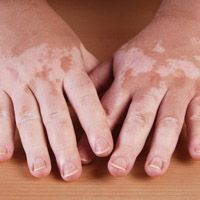News
Article
Alopecia Versus Vitiligo: Spotlighting Differences in Psychological Impact
Author(s):
These findings may require further evaluation using classification of age range as well as severity of disease, allowing for more precise results.

Patients with alopecia areata (AA) may have higher levels of anxiety and depression and lower quality of life (QoL) compared to vitiligo cases, according to new findings, though no differences in sleep disturbances are known to occur.1
These results came from a recent study conducted to look into the distinctions and the similarities in the psychological aspects of both AA and vitiligo. Some of these elements assessed by the investigators included QoL, anxiety, disturbances in sleep, and depression levels.
The research was led by Fariba Ghalamkarpour, MD, from the Skin Research Center at Shahid Beheshti University of Medical Sciences in Tehran, Iran. The provision of mental health support for patients, Ghalamkarpour and colleagues noted, is known to help patients' well-beings as well as to reduce the burden on their caregivers and society in general.2
“Considering the similarities and differences between these two disorders, as well as the lack of research comparing their comprehensive psychological aspects, we tried to perform a study to compare the quality of life, anxiety, depression, and sleep disturbance among patients with AA or vitiligo…” Ghalamkarpour and colleagues wrote.
Background and Findings
The investigators recruited participants with diagnosed vitiligo or AA cases from the outpatient dermatologic clinic, and this period of enrolment took place from November 2017 - December 2020. They made the criteria for exclusion be insufficient data for a precise diagnosis, being under 14 years, and disagreement related to participation in the research.
The subjects were asked by the research team to do 3 questionnaires. These were the hospital anxiety and depression scale (HADS), dermatology life quality index (DLQI), and Pittsburgh sleep quality index (PSQI).
The team examined information related to participants’ sex, age, marital status, history of drug use, related conditions, and education. They created a Persian version of the DLQI questionnaire with a Cronbach's alpha coefficient of 0.77, implementing this to examine the subjects’ QoL.
The investigators used the DLQI and included 10 questions using 4-point scale responses, and they categorized this into 6 total groups highlighting distinct elements of life. There was a range from 0 - 30 in the total score.
The HADS questionnaire was used by the research team to evaluate participants’ levels of anxiety and depression with 14 items (7 for each of the 2 domains). They used the self-reported PSQI-P, made up of 19 questions, to assess 7 elements of subjects’ sleep quality.
Overall, the investigators ended up looking at data from 188 individuals, with 50% being those with diagnoses of AA and the other 50% being those with vitiligo. The team found a much higher DLQI score among participants with AA (P = 0.002) versus those with vitiligo, suggesting better QoL among those in the vitiligo cohort.
Furthermore, the investigators noted that those with AA showed higher anxiety scores (P<0.001) as well as depression scores (P<0.001). Despite these notable differences and the fact that sleep disturbances are high among both arms, the team found that there was not a statistically significant difference between cohorts (64.9% of participants with AA versus 59.3% of those with vitiligo; P=0.4888).
“Further studies with the classification of age range and disease severity will lead to more precise results,” they language. “We suggest additional studies with larger sample sizes and closer age range.”
References
- Ghalamkarpour F, Araghi F, Tabari M, Moslemi Haghighi S, Pourgholi E. Comparing quality of life, anxiety, depression, sleep disturbance, and associated factors in vitiligo and alopecia areata patients. J Cosmet Dermatol. Published online January 3, 2024. doi:10.1111/jocd.16158.
- Savaş Erdoğan S, Falay Gür T, Doğan B. Anxiety and depression in pediatric patients with vitiligo and alopecia areata and their parents: a cross-sectional controlled study. J Cosmet Dermatol. 2021; 20(7): 2232-2239.




